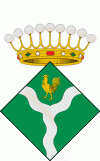Ripoll
 |
 |
The first traces of humans inhabiting the area date from the Bronze Age and can be seen in form of dolmens such as those found in El Sot de Dones Mortes or in Pardinella. This area was later used by peoples from the Atlantic culture to store bronze weapons and as a passway from the Catalan Central Depression to the Pyrenees. The area also has tombs from the late Roman occupation age and some belonging to the Visigoths.
It has a famous Benedictine monastery built in the Romanesque style, Santa Maria de Ripoll, founded by the count Wilfred the Hairy in 879. The count used it as a centre to repopulate the region after conquering it. In the High Middle Ages, its castle, the Castle of Saguardia, located in the county of Les Llosses was ruled by the Saguàrdia family, of which Ponç de la Guàrdia was a famous troubadour.
An abundance of coal and iron ore, coupled with the ample water supply of the rivers Ter and Freser, encouraged a metal-working industry in the early Middle Ages. The furnaces of Ripoll were a prime source of nails for the peninsula. Later, pole arms and crossbows, always in demand, were added to Ripoll's exports. Ripoll enjoyed a reputation throughout Europe for the production of firearms. That success as a manufactory of firearms brought frequent trouble to the city. French invasions in 1794, 1809, 1812, and 1813 crippled the city industries. However, the final and utter destruction of Ripoll, resulting from mines and blasting, occurred in 1839 during the Carlist Wars. Due to the loss of records and archives, not much is known of Ripoll and its industry to this day.
* Ethnographic Museum of Ripoll
Map - Ripoll
Map
Country - Spain
 |
 |
| Flag of Spain | |
Anatomically modern humans first arrived in the Iberian Peninsula around 42,000 years ago. The ancient Iberian and Celtic tribes, along with other pre-Roman peoples, dwelled the territory maintaining contacts with foreign Mediterranean cultures. The Roman conquest and colonization of the peninsula (Hispania) ensued, bringing the Romanization of the population. Receding of Western Roman imperial authority ushered in the migration of different non-Roman peoples from Central and Northern Europe with the Visigoths as the dominant power in the peninsula by the fifth century. In the early eighth century, most of the peninsula was conquered by the Umayyad Caliphate, and during early Islamic rule, Al-Andalus became a dominant peninsular power centered in Córdoba. Several Christian kingdoms emerged in Northern Iberia, chief among them León, Castile, Aragon, Portugal, and Navarre made an intermittent southward military expansion, known as Reconquista, repelling the Islamic rule in Iberia, which culminated with the Christian seizure of the Emirate of Granada in 1492. Jews and Muslims were forced to choose between conversion to Catholicism or expulsion, and eventually the converts were expelled through different royal decrees.
Currency / Language
| ISO | Currency | Symbol | Significant figures |
|---|---|---|---|
| EUR | Euro | € | 2 |
| ISO | Language |
|---|---|
| EU | Basque language |
| CA | Catalan language |
| GL | Galician language |
| OC | Occitan language |
| ES | Spanish language |















